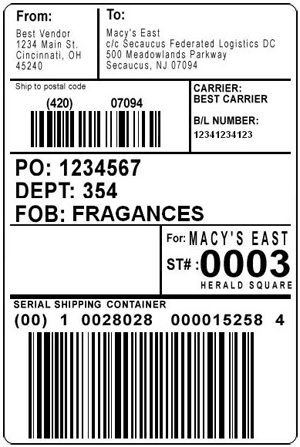…great read from Supply Chain Digest this month on how to incorporate print-and-apply automation for changing package sizes while remaining compliant with changing retail requirements.
Supply Chain News: Label Print and Apply Systems in Distribution Center Operations Can Drive Real Value, but It Takes Sophisticated Technology
Labels for Inbound Receiving, Parcel Deliveries and Retail GSI-128 Labels are Common Applications, But Just How Does the Applicator Know What Retail Label to Print?
SCDigest Editorial Staff
Label printer-applicators are of course very prevalent in manufacturing operations, but certainly have many distribution center applications as well, notably for printing of shipping labels, and especially for printing and applying GS1-128 labels (formerly the UCC-128) to meet retail compliance requirements.
 The big difference in distribution center applications as opposed to manufacturing is the dynamic nature of the requirements. In general, manufacturing applications involve batches of product that for a time are uniform in size/shape (e.g., cartons of the same SKU), and perhaps more importantly may have the same static product information and bar code identifiers for every label in the batch.
The big difference in distribution center applications as opposed to manufacturing is the dynamic nature of the requirements. In general, manufacturing applications involve batches of product that for a time are uniform in size/shape (e.g., cartons of the same SKU), and perhaps more importantly may have the same static product information and bar code identifiers for every label in the batch.
Even serialized individual products, such as in the high tech industry, may not have a unique serialized bar code identifier on the master case itself built in assembly operations (though some certainly do).
Contrast that with compliance shipping label applications, where the size of every box coming down a conveyor line might be different, and more challengingly, not only will some of the data on the label likely change with every label printed, the format (design) of the label itself will vary from retailer to retailer even under the broad GS1-128 standard.
That requirement not only adds to the processing time needed to print and apply a label, it means the printer-applicator needs to be controlled by an integrated software application, often a module of a warehouse control system (WCS), though it might also be a standalone application, or even involve direct control by the warehouse management system (WMS), though this is not common.
Many manufacturing applications, by contrast, could be managed with just a standard bar code labeling program such as Loftware, Teklynk, Seagull Scientific and others that operate more in a standalone mode, though those programs can also be connected to enterprise systems as well…[more]
Read the complete article at: http://www.scdigest.com/ontarget/16-01-05-1.php?cid=10100

